10 Best TensorFlow Courses to Take in 2024
An in-depth guide on the best online courses for learning TensorFlow. Learn Google’s popular ML library!
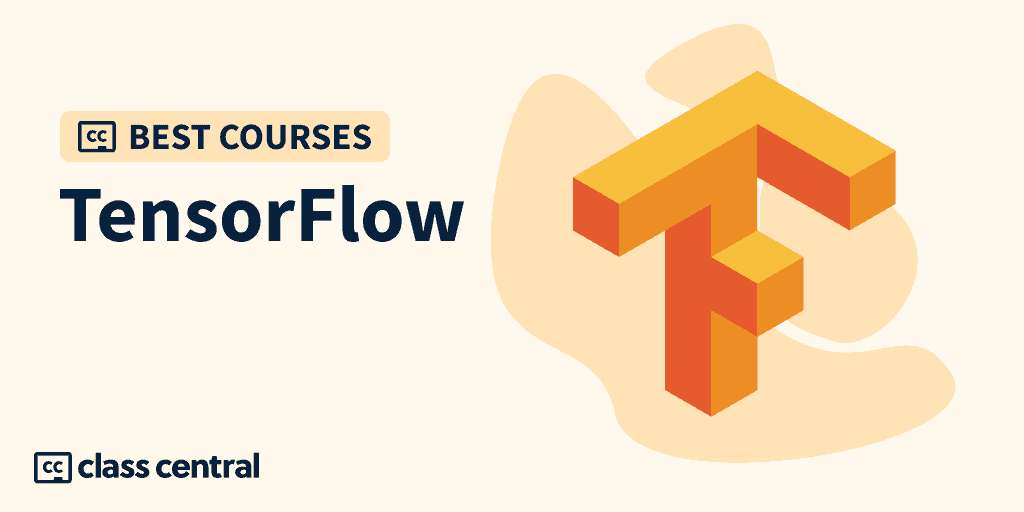
TensorFlow is a very popular free and open-source machine learning library created by Google.
In this guide, I’ve used Class Central’s catalog of over 100K courses to find the best online courses for learning TensorFlow.
If you’d like to know how I chose these courses, you can find my methodology below. But if you’re here for the list, here are my top picks. Click on one to skip to the details:
| Course | Workload | In Brief |
| 1. Introduction to TensorFlow (DeepLearning.AI) | 20 hours | Best complete course for beginners |
| 2. Intro to TensorFlow for Deep Learning (TensorFlow) | 8 weeks | Comprehensive course made by TensorFlow themselves |
| 3. Getting started with TensorFlow 2 (Imperial) | 26 hours | Entire ML / DL workflow for TensorFlow |
| 4. Learn TensorFlow and deep learning, without a Ph.D. (Google) | 3 hours | Short and sweat course for the curious |
| 5. Deep Learning with Tensorflow (IBM) | 16 hours | For novices; covers many TensorFlow applications |
| 6. Practical Machine Learning with Tensorflow (IIT Bombay) | 16 hours | Emphasizes a hands-on approach |
| 7. TensorFlow Fundamentals (Microsoft) | 6 hours | TensorFlow primer via Jupyter Notebooks |
| 8. End-to-End Machine Learning with TensorFlow on GCP (Google) | 18 hours | Learn how to deploying your models |
| 9. Custom Models, Layers, and Loss Functions with TensorFlow (DeepLearning.AI) | 25 hours | For advanced learners; covers the tech details |
| 10. TensorFlow Developer Certificate in 2022: Zero to Mastery (Udemy) | 64 hours | Paid course to prepare for the TensorFlow certification exam |
What is TensorFlow?
TensorFlow is a comprehensive open source library for machine learning. Originally created at Google as an internal tool before being open sourced in 2015, it has become incredibly popular over the years as artificial intelligence gained prominence.
The reason why TensorFlow is one of the best libraries to implement machine learning applications, including deep learning, is its comprehensive, flexible ecosystem of tools and community resources. It allows researchers to push the state-of-the-art in ML and developers to easily build and deploy ML-powered applications.
According to PayScale, TensorFlow skills command salaries of over $100K in the US. One of the ways to prove yourself as a TensorFlow expert is to take the official TensorFlow Developer Certificate. If you pass the exam, you can join Google’s Certificate Network ensuring recruiters recognize your TensorFlow skills.
Course Ranking Methodology
I built this ranking following the now tried-and-tested methodology used in previous rankings (you can find them all here). It involves a three-step process:
First, let me introduce myself. I’m part of the Class Central team, and I (@elham) built this ranking in collaboration with my friend and colleague @manoel.
We started off with a data-driven process by leveraging Class Central’s database of 100K courses to make a preliminary selection of TensorFlow courses. We took into account things like ratings, reviews, and course bookmarks to gauge what are the most popular Tensorflow courses.
But we didn’t stop there. Ratings and reviews rarely tell the whole story. So the next step was to bring our personal knowledge of online education into the mix.
Second, we used our experience as online learners to evaluate each preliminary pick.
Both of us come from computer science backgrounds and are prolific online learners, having completed about 45 MOOCs between us. Additionally, Manoel has an online bachelor’s in computer science, while I am currently completing my foundation in computer science.
After carefully analyzing each course, bouncing ideas off each other, and making iterative improvements to the rankings until we were both satisfied, we’ve come up with a selection of the top courses out there. But there’s one more step which we took.
Third, during our research, we stumbled across courses that we felt were well-made but weren’t well-known. Had we adopted a purely data-centric approach, we would be forced to leave those courses out of the ranking just because they had fewer enrollments.
So we decided instead to take a more holistic approach. The courses in this ranking range from beginner to expert, as well as theory to practice focused.
After going through this process — combining Class Central data, our experience as lifelong learners, and a lot of editing — we arrived at our final ranking. So far, we’ve spent more than 10 hours building this ranking, and we intend to continue updating it in the future.
Course Ranking Statistics
Here are some aggregate stats about the ranking:
- The largest course in this ranking has close to 300K enrollments.
- In total, the courses account for 450K enrollments.
- 9 courses are free or free-to-audit and only 1 is paid.
- 2.8K people follow Class Central’s TensorFlow Courses.
- The most represented provider is Coursera with 4 courses, whereas the rest are distributed over many different platforms.
Without further ado, let’s get to the top picks.
1. Introduction to TensorFlow for Artificial Intelligence, Machine Learning, and Deep Learning (DeepLearning.AI)
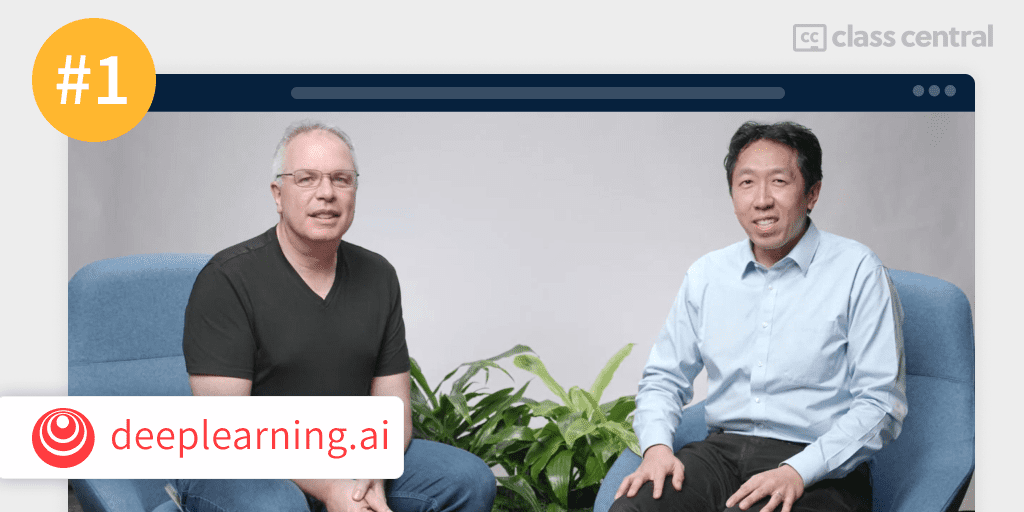
My #1 pick for the best TensorFlow course is Introduction to TensorFlow for Artificial Intelligence, Machine Learning, and Deep Learning, offered by DeepLearning.AI on Coursera.
This course is my top pick for anyone completely new to machine learning (ML) or deep learning (DL) that wants to learn TensorFlow. It will help you build powerful, scalable AI-powered algorithms for all sorts of purposes.
To take this course, you’ll need experience in Python and an understanding of high school-level math. No prior experience with machine learning is required.
What You’ll Learn
The course begins with a brief introduction to machine learning and deep learning. With these foundations in place, you’ll be able to explore exciting scenarios. For example, you’ll learn how to monitor and analyze housing prices, and make predictions about their fluctuations using a single-layer neural network implemented using TensorFlow.
The next part of the course is all about computer vision — enabling computers to ‘see’ and understand images. Your task is to build a multilayer neural network for classifying the Fashion MNIST dataset, which comprises images of clothing items. To do this, you’ll track model loss and accuracy during training, investigate the impact of layer size on the network predictions and training speed, and speed up the training process by implementing pixel value normalization.
Although the neural network you’ve built for computer vision works just fine, we can do better! Convolutional neural networks are geared specifically toward computer vision tasks, and you’ll learn all about them in the third module and even build one. This will allow you to see for yourself how it improves on previous approaches in terms of efficiency and accuracy.
So far, you’ve been dealing with the basic MNIST dataset which has been cleaned up for you. But real-world datasets are rarely that clean. What if your images are of different sizes, or if features aren’t always in the same place? You’ll learn how to deal with such complex images using Keras. And you’ll build a multilayer neural network for binary classification in your final project.
How You’ll Learn
This course is 4 weeks long, with each week involving 4–5 hours of study. You’ll study primarily from lecture videos, assigned readings, and hands-on coding projects.
Each week comes with a quiz and a coding assignment that you’ll have to complete. These are only accessible to paid learners.
| Organization | DeepLearning.AI |
| Provider | Coursera |
| Instructor | Laurence Moroney |
| Level | Intermediate |
| Workload | 20 hours total |
| Enrollments | 286K |
| Rating | 4.7 / 5.0 (17K) |
| Certificate | Paid |
Fun Facts
- This course is the first of four in the DeepLearning.AI TensorFlow Developer Professional Certificate. The next course is Convolutional Neural Networks in TensorFlow.
- The professional certificate aims to teach you best practices and techniques to build scalable AI-powered applications with TensorFlow.
- Laurence Moroney is an AI Lead at Google. His vision is to make AI easy for developers and to widen access to ML careers for everyone.
If you’re interested in this course, you can find more information about the course and how to enroll here.
2. Intro to TensorFlow for Deep Learning (TensorFlow)
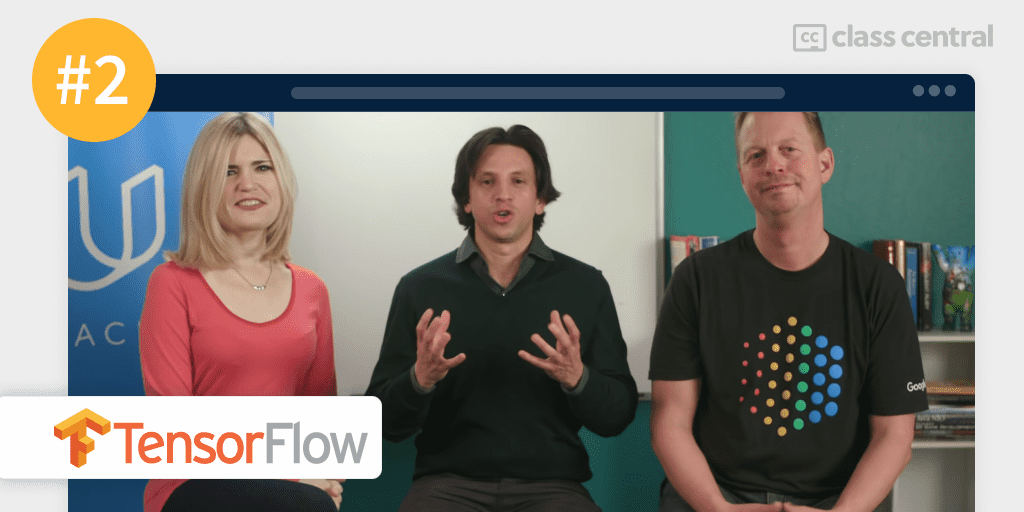
My second pick for the best TensorFlow course is Intro to TensorFlow for Deep Learning, created by Google’s TensorFlow team in collaboration with Udacity.
This hands-on course will teach you how to build deep learning applications like state-of-the-art image classifiers and other models with TensorFlow. You will also learn advanced techniques to work with large datasets. By the end of this course, you’ll have all the necessary skills to develop your own AI applications.
Before taking this course, you should have some basic Python programming skills, familiarity with object-oriented programming, and know basic algebra.
What You’ll Learn
The course begins with a high-level overview of AI and machine learning and answers several important questions like “What’s the difference between AI, machine learning, and deep learning, and what does TensorFlow have to do with it?”.
After getting the framework down, you’ll get your first taste of machine learning by creating and training a neural network that can recognize images of articles of clothing from the Fashion MNIST dataset. Then, you’ll significantly improve your model performance by looking at a different kind of neural network: Convolutional Neural Networks (CNN).
Indeed, there are many flavors of neural networks, each suited for its own purpose, and in this case, you’ll learn about CNNs for image recognition. You’ll dive deep into the complexities of CNNs, allowing it to tackle tasks such as distinguishing cats and dogs.
One of the downsides of machine learning is that it takes time to train. Imagine how much time we can save by skipping training entirely. In fact, that’s what transfer learning allows! You’ll learn how to load in pre-trained networks, tweak their parameters, and save your modified models — all of it made easy by TensorFlow.
The course also explores time-series forecasting, or put simply, predicting the future from historical data. By the way, this section is taught by the legendary Aurélien Géron, the author of the book that can essentially be called the Bible of machine learning.
Then, the course shifts its focus to Natural Language Processing (NLP), which teaches machines to understand and interpret human language. Finally, you’ll study Recurrent Neural Networks (RNNs) and watch in amazement at how they can generate text, like coming up with song lyrics!
The course wraps up with an optional but recommended introduction to TensorFlow Lite, a lighter but still powerful version of TensorFlow for building machine learning apps on Android, iOS, and IoT devices, although it is actually a separate course on its own.
How You’ll Learn
This course is 8 weeks long. The videos have excellent production quality and there are plenty of resources for you to go through.
Each lesson given in the course comes with at least one coding assignment in Google Colab for you to implement what you’ve learnt.
| Organization | TensorFlow |
| Provider | Udacity |
| Instructors | Magnus Hyttsten, Juan Delgado, and Paige Bailey |
| Level | Intermediate |
| Workload | 8 weeks long |
| Certificate | None |
Fun Facts
- If you’d like to learn more about time-series forecasting, the course recommends you take Time Series Forecasting by Tony Moses.
- Magnus Hyttsten and Paige Bailey, two of the course instructors, work at Google as Developer Advocates. Besides their technical skills, they truly have a knack for explaining things.
If you’re interested in this course, you can find more information about the course and how to enroll here.
3. Getting started with TensorFlow 2 (Imperial College London)
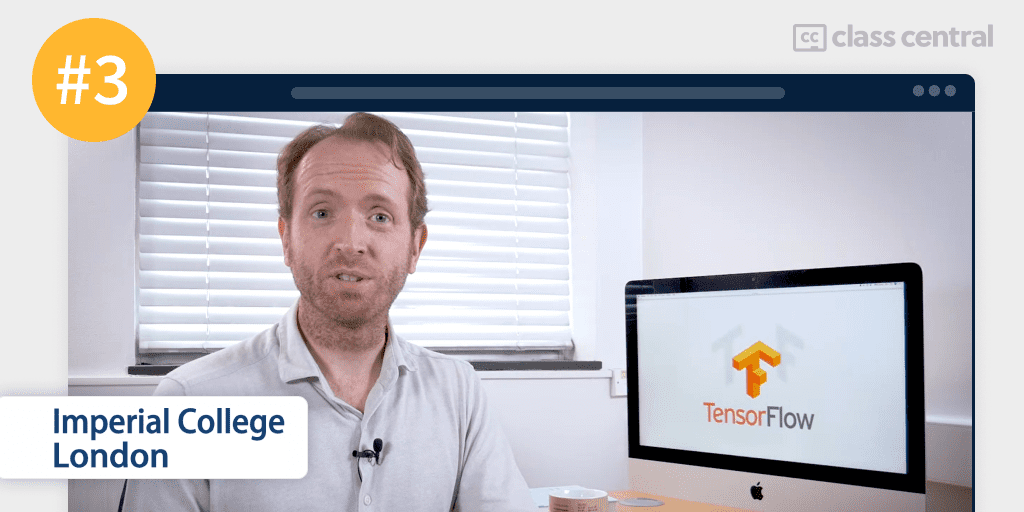
My third pick for the best TensorFlow course is Getting started with TensorFlow 2 offered by Imperial on Coursera.
This course helps Python programmers who already have working knowledge of ML and DL build deep learning models with TensorFlow.
You’ll learn an end-to-end workflow for developing deep learning models with Tensorflow, including building, training, and evaluating models using the Sequential API. You’ll also develop deep learning models for a range of applications, including image classification, texts, sentiment analysis, regression tasks, and generative language models.
What You’ll Learn
The first week of the course will help you get familiar with the capabilities of TensorFlow. After that, you’ll learn how to install or update TensorFlow 2 and learn to navigate the TensorFlow documentation when needed. You’ll also learn how to run TensorFlow programs on Google Colab.
The second week of the course introduces Keras. First, you’ll explore the various options Keras offers to facilitate the model-building process, like building and training models with different loss functions and optimizers, as well as different methods for evaluating model performance. Then, you’ll put what you’ve learned into practice by developing an image classifier with convolutional neural networks on the MNIST dataset of handwritten digits.
Model validation and selection are essential when developing machine learning models, as they help prevent overfitting. In the third week, you’ll learn how to use validations sets, monitor overfitting during training and implement regularization and dropout layers. Finally, you’ll apply what you’ve been taught on the Iris dataset.
The fourth and final week before the capstone project instructs you on the specifics of saving and loading TensorFlow models, like how to automatically save models and load pre-trained models and components. The programming assignment will require you to write flexible saving and loading implementations for a model trained on satellite images.
In the capstone project, you’ll develop a deep learning classifier on a labeled image dataset of street view house numbers.
How You’ll Learn
This course is 5 weeks long, with 26 hours worth of material. The course provides lecture videos and readings.
Regarding assessments, if you are a paid learner, at the end of each week of course there will be a programming assignment in Jupyter Notebooks, where you’ll need to apply the concepts you learned from that week. In addition, you’ll complete a capstone project. It will be peer-assessed, so you’ll be able to give and get useful feedback from your peers.
| Institution | Imperial College London |
| Provider | Coursera |
| Instructor | Kevin Webster |
| Level | Intermediate |
| Workload | 26 hours total |
| Enrollments | 26K |
| Rating | 4.9 / 5.0 (437) |
| Certificate | Paid |
Fun Facts
- Getting started with TensorFlow 2 is the first course of the TensorFlow 2 for Deep Learning Specialization. It is intended for machine learning researchers and practitioners who are seeking to develop practical skills in the popular deep learning framework TensorFlow.
- Besides offering a flurry of online courses on machine learning, Imperial also offers an online master’s degree in machine learning via Coursera.
If you’re interested in this course, you can find more information about the course and how to enroll here.
4. Learn TensorFlow and deep learning, without a Ph.D. (Google)
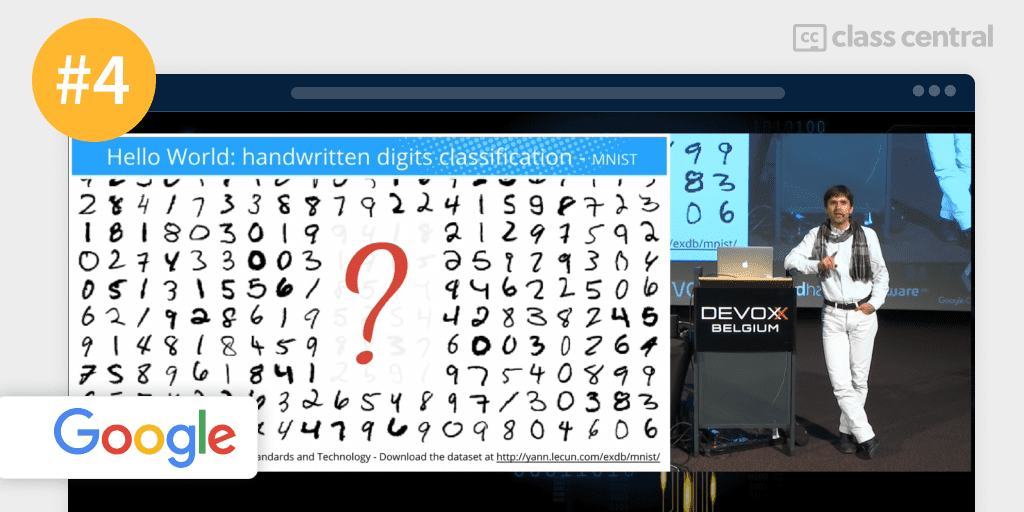
If you’re here to see what the fuss with TensorFlow and deep learning is all about, this short 3-hour course will get you up to speed.
Learn TensorFlow and deep learning, without a Ph.D. distances itself from the technical jargon and instead teaches you the fundamental concepts.
It focuses on a few basic network architectures, including dense, convolutional, and recurrent networks, and training techniques such as dropout or batch normalization.
By the end of the course, you’ll have all the necessary bits and pieces needed to study deep learning in-depth.
What You’ll Learn
The course begins with an introduction to deep learning. You’ll explore a simple but famous application of deep learning: recognizing handwritten digits. Next, you’ll learn what ingredients are needed to concoct an effective neural network!
Convolutional networks are a type of neural network highly suitable for image recognition tasks! You’ll study how convolutional networks work and how we can improve their effectiveness with batch normalization.
After learning the essentials of TensorFlow high-level API, you’ll move on to another kind of neural network known as recurrent neural networks. Recurrent neural networks are great for text processing tasks, and here you’ll do something fun: recreate Shakespeare writing with neural networks! Finally, you’ll learn how to use TensorFlow with the Google Cloud Machine Learning platform to save and deploy your models.
How You’ll Learn
This course is 3 hours long but packs a lot of information. You’ll watch the course recording and have access to annotated slides along with the codelab to gain hands-on experience with deep learning.
| Institution | |
| Instructor | Martin Görner |
| Level | Beginner |
| Workload | 3 hours total |
Fun Facts
- Martin Görner is the Product Manager for Keras and Tensorflow at Google, and an advocate of ML democratization.
- The course has over 400 bookmarks on Class Central.
If you’re interested in this course, you can find more information about the course and how to enroll here.
5. Deep Learning with Tensorflow (IBM)
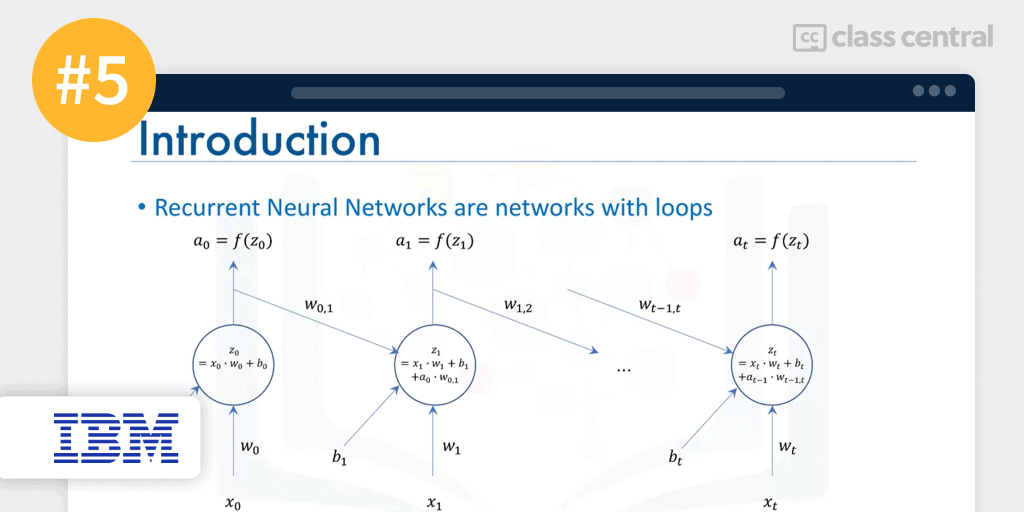
In this TensorFlow course by IBM, you will learn the basic of TensorFlow — from the main functions, to operations, and to the execution pipeline — and start building your own deep learning application!
Deep Learning with Tensorflow begins by teaching you the fundamentals of machine learning (curve fitting, regression, classification) and then applies them to the deep learning world specifically. You’ll learn all about the intricacies of deep neural networks as well as the different types of architectures like convolutional networks, recurrent networks, and autoencoders.
To take this course, all you need is prior experience in Python programming.
What You’ll Learn
After introducing you to the TensorFlow library and walking you through the “Hello World!” of machine learning, the course goes over a few basic machine learning algorithms, like linear and logistic regression.
Next, you’ll learn about convolutional neural networks (CNN), powerful models suitable for object recognition, among others. Similar to how human brains function, CNNs work by passing the inputs through a sequence of complex layers made up of computational neurons. You’ll learn what convolutions are exactly before developing a CNN that recognizes handwritten digits.
We’ve worked with image data in the previous model, but what about processing sequential data like audio signals and language? For these, you’ll want to use a different architecture known as recurrent neural networks (RNN). You’ll study their inner workings and use RNNs for natural language processing (NLP).
Module 4 introduces unsupervised learning. What we’ve done previously is classify into predetermined categories. Unsupervised learning instead figures out the categories by itself. Here, your primary focus will be on the Restricted Boltzmann Machine. After creating and training this model in TensorFlow, you’ll use it to build a movie recommendation system.
In module 5, you’ll dive deeper into unsupervised learning and study Autoencoders, most famously used in dimensionality reduction. Finally, you’ll end by implementing an Autoencoder in TensorFlow.
Great, you know how to build a deep learning model with TensorFlow! Eventually, you’ll want to scale your model training. The sixth (optional) module teaches you to train your machine learning model with IBM’s Watson Studio using multi CPU or GPU runtimes.
How You’ll Learn
This course is 5 weeks long, with 2–4 hours of study per week. The course includes well-produced video lectures and many supplement resources for you to learn.
If you’re paying for the certificate, each non-optional module comes with a set of review questions that will help you retain what you’ve been taught. The course ends with a final exam.
| Institution | IBM |
| Provider | edX |
| Instructors | Saeed Aghabozorgi, Romeo Kienzler, and Samaya Madhavan |
| Level | Intermediate |
| Workload | 16–20 hours total |
| Enrollments | 45K |
| Certificate | Paid |
Fun Facts
- Deep Learning with Tensorflow is part of IBM’s Deep Learning Professional Certificate, where it explores other machine learning libraries like Keras and PyTorch.
- If you successfully complete this course, you’ll earn IBM’s digital credential to show off the knowledge and skills you’ve acquired in this course.
If you’re interested in this course, you can find more information about the course and how to enroll here.
6. Practical Machine Learning with Tensorflow (Indian Institute of Technology Bombay)
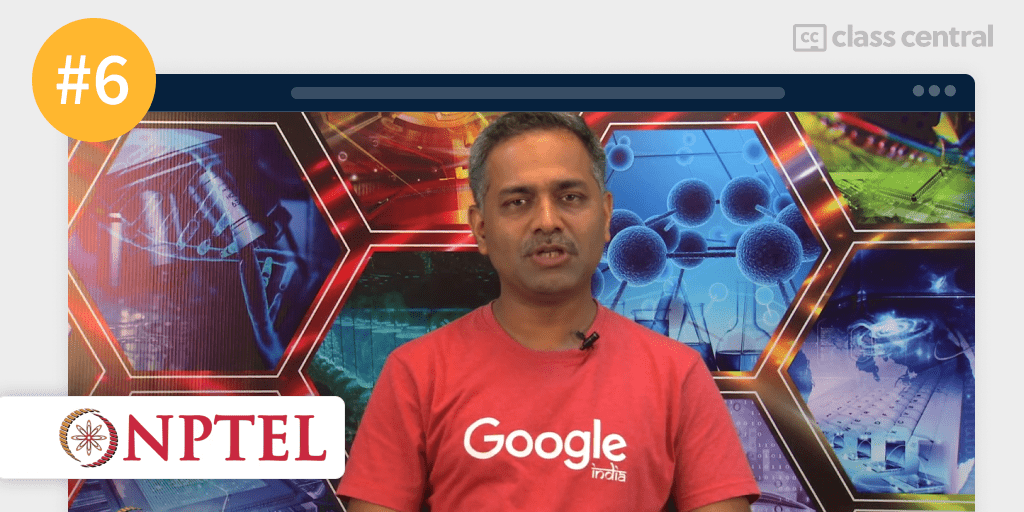
A joint collaboration between Google and IIT, Practical Machine Learning with Tensorflow aims to cover Tensorflow and Machine Learning from the basics to advanced topics. Upon completion, you’ll be able to build a wide variety of ML models using Tensorflow.
You’ll need to be proficient in Python programming, as well as have taken an introductory course to machine learning or data science in order to take this course.
What You’ll Learn
You’ll begin your journey by learning about TensorFlow.
You’ll go over the fundamentals of machine learning. Here you’ll learn about things like loss functions, gradient descent, model selection, overfitting, and more..
One of the reasons why TensorFlow is so popular is because it is simple to use — well, as simple as it gets when it comes to deep learning! You’ll begin building your first machine learning model. This requires a lot of steps, like building a data pipeline, choosing a model, predicting outputs, and monitoring and evaluating models with TensorBoard. Luckily, the course will teach you all this and more.
Now that you have the ML concepts sorted out, we can move on to deep learning. Here, you’ll grasp the mathematical foundations of deep learning as well as all the parts that make up neural networks like tensors and neurons. Then, you’ll get to know the convolutional neural networks (CNN), popularly used to classify images. As training CNNs can get extremely computationally expensive (images are huge!), you’ll learn how to use pre-trained CNNs with transfer learning to speed up the training process.
You’ll also learn about recurrent neural networks (RNN), which are used heavily in applications that deal with sequential data, like text or sound. You’ll learn how to represent and package text into something delectable for the neural network. You’ll do some wizardry with RNNs, like forecasting the future and generating tons of readable text!
How You’ll Learn
This course has 16 hours worth of material. You’ll learn primarily from watching the video lectures and following along the instructor coding.
| Institution | Indian Institute of Technology Bombay |
| Provider | YouTube |
| Instructor | Ashish Tendulkar and Balaraman Ravindran |
| Level | Beginner |
| Workload | 16 hours total |
| Views | 76K |
Fun Facts
- Ashish Tendulkar is a ML specialist at Google with over 18 years of experience of working in the domain of AI and machine learning.
- Ravindran is the head of the Robert Bosch Center for Data Science and Artificial Intelligence at IIT Madras and a professor and Mindtree Faculty Fellow in the Department of Computer Science and Engineering.
If you’re interested in this course, you can find more information about the course and how to enroll here.
7. TensorFlow fundamentals (Microsoft)
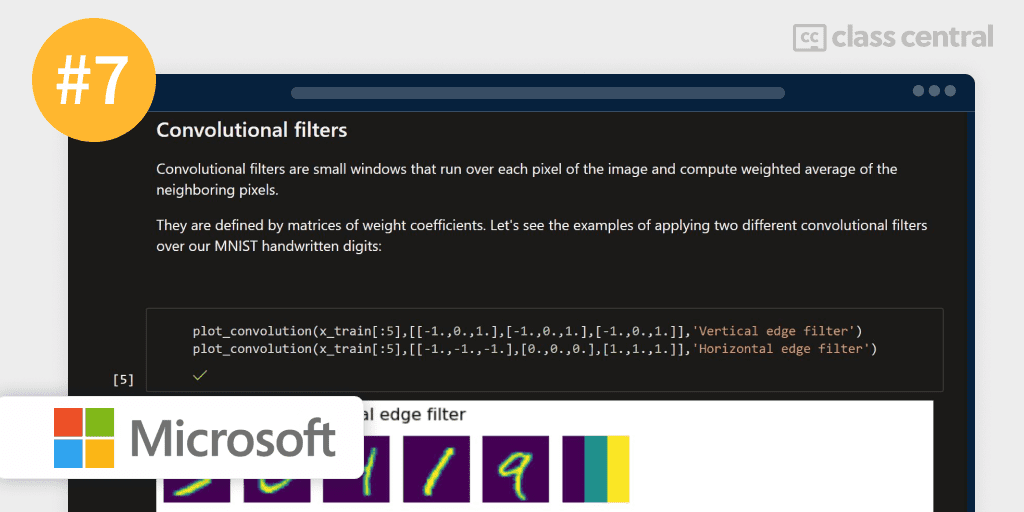
TensorFlow fundamentals by Microsoft is a concise introduction to the fundamentals of deep learning with TensorFlow. This beginner-friendly learning path will introduce key concepts for building machine learning models. You’ll explore computer vision, natural language processing, and audio classification projects throughout your journey.
The prerequisites for this course are basic Python knowledge and a basic understanding of machine learning.
What You’ll Learn
The first module covers all the concepts and basic tools you need to get started with TensorFlow. You’ll learn how to prepare your data, how to define your neural network, how to train and test it, and finally how to make predictions using your trained network. You’ll do all of this with Keras, a high-level API released as part of TensorFlow.
Convolutional neural networks (CNN) are a powerhouse of computer vision. In the second module, you’ll study how CNNs work, their structure, and how they can capture patterns in 2D images. You’ll learn how pre-trained networks and transfer learning speed up things by skipping the training process.
In the third module, you’ll learn the basics to get started with natural language tasks. You’ll also explore different neural network architectures, like recurrent neural networks (RNNs) and generative neural networks (GNNs).
Virtual assistants wouldn’t be so amazing and useful without voice recognition. We know how to make machines understand images, so why not turn sounds into images? In the fourth module, you’ll learn how to represent sound in the form of spectrograms and then build a binary classification model that utilizes computer vision to recognize “yes” and “no”. How ingenious!
How You’ll Learn
This course consists of 5 modules and is 5 hours long. You’ll learn mainly through the Jupyter Notebooks the course provides. At the end of each unit, there will be a quiz that’ll test whether you understood the material.
| Institution | Microsoft |
| Level | Beginner |
| Workload | 5 hours total |
Fun Facts
- This course is a part of Class Central’s resource compilation for preparing for Microsoft Azure Certifications and Exams.
If you’re interested in this course, you can find more information about the course and how to enroll here.
8. End-to-End Machine Learning with TensorFlow on GCP (Google)
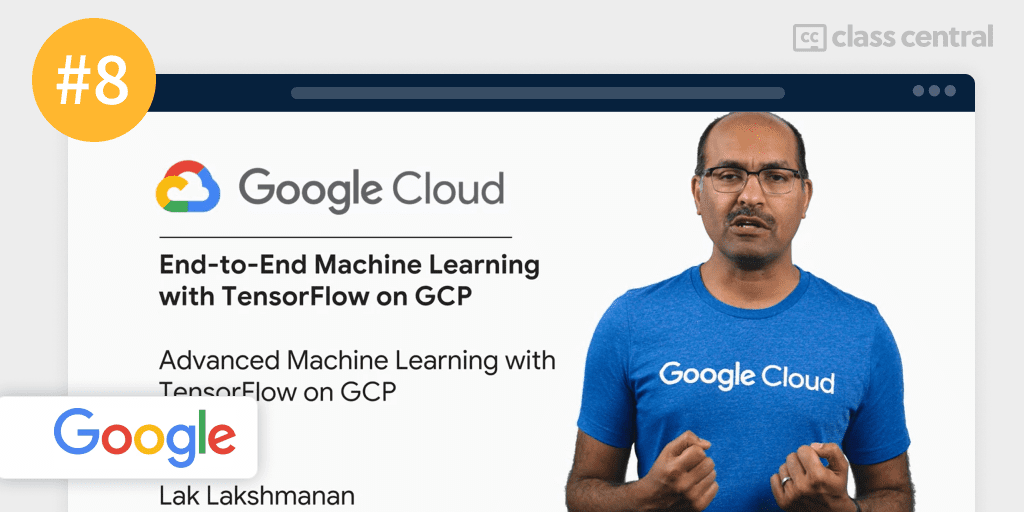
One of the best ways to deepen your understanding is to work with the concepts and technologies that you have learned.
Google’s End-to-End Machine Learning with TensorFlow on GCP aims to help you understand the processes underpinning machine learning, from data exploration all the way to deploying your ML models on Google Cloud.
This course is more of a workshop on ML than a class.
This course assumes you have completed the Machine Learning with TensorFlow on Google Cloud Platform Specialization, or are familiar with basic SQL, Python, and TensorFlow.
What You’ll Learn
The first step of any ML workflow is exploring the data and selecting different features from your dataset, also known as feature engineering. You’ll learn how to use BigQuery and Datalab to help you wade through huge datasets in your first lab.
You’ll create full-sized training and evaluation datasets, implementing preprocessing operations in Cloud Dataflow.
In another lab., you’ll train your model. One of the advantages of using TensorFlow is that it is able to do distributed training — that is, splitting large datasets into smaller datasets, and training your model on each subdataset. The training will be distributed and scaled out on Cloud ML Engine. Finally, you’ll deploy the trained model and use it to generate predictions.
How You’ll Learn
This course involves 3 weeks of study, with each week taking 8–10 hours per week. As this course is primarily hands-on, it will review the key concepts that you’ll need for the labs. There are 6 labs in total, with one optional one.
| Institution | |
| Provider | Coursera |
| Level | Advanced |
| Workload | 24–30 hours total |
| Enrollments | 55K |
| Rating | 4.5 / 5.0 (1.6K) |
| Certificate | Paid |
Fun Facts
- This course is the first course of Advanced Machine Learning on Google Cloud Specialization. It teaches you how to perform machine learning at scale and how to build specialized machine-learning models for images, sequences, and recommendations
If you’re interested in this course, you can find more information about the course and how to enroll here.
9. Custom Models, Layers, and Loss Functions with TensorFlow (DeepLearning.AI)
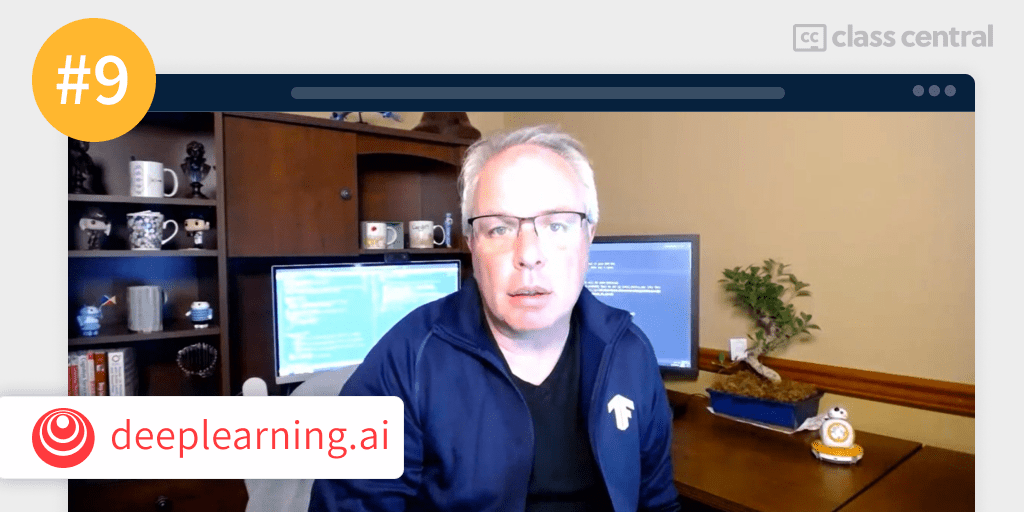
If you want to be ahead of the curve, you’ll need to be able to build your own custom ML or DL models. This course will help you do just that!
Custom Models, Layers, and Loss Functions with TensorFlow from DeepLearning.AI aims to help those already familiar with the foundations of TensorFlow gain more control over their model architecture.
To take this course, you’ll need knowledge of AI and deep learning as well as the math that underpins them. You’ll also need experience with Python and either TensorFlow, Keras, or the PyTorch framework.
What You’ll Learn
Most beginners start using TensorFlow using the Sequential API. But do you know there’s a more flexible way to code layers and design models? Enter Functional API. You’ll practice programming with the Functional API and eventually build a form of multi-output model called a Siamese network which measures similarities between two instances like handwriting or human faces.
Loss functions measure model performance, but sometimes there is a kind of unwanted side effect of using standard loss functions, like being too sensitive to data outliers. The following section teaches you how to build your own custom loss function, the Huber loss function used in a Siamese network, and improve your model performance!
Moving away from loss functions, you’ll first explore lambda layers and then watch how custom layers can be more useful than lambda layers.
You’ll define your own custom model class and extend its functionality far beyond what’s available with the Functional or Sequential APIs. Then, you’ll inherit from TensorFlow’s Model class to create a ResNet model on your own. You’re definitely taking off the training wheels at this point.
In the bonus section, you’ll learn about customizing callbacks — what your model outputs or how it behaves during training. Callbacks are helpful as they track the model’s performance during training and prevent overfitting, but only if they know how to recognize overfitting. So you’ll specify a custom callback to stop training once the callback detects overfitting.
How You’ll Learn
This course is 5 weeks long, with each week taking 5 hours of study. You’ll learn by watching the handy lecture videos and completing the weekly programming assignments. The assessments are only available to paid learners.
| Institution | DeepLearning.AI |
| Provider | Coursera |
| Instructors | Laurence Moroney and Eddy Shyu |
| Level | Intermediate |
| Workload | 25 hours total |
| Enrollments | 18K |
| Rating | 4.9 / 5.0 (680) |
| Certificate | Paid |
Fun Facts
- This course is the first of four in the TensorFlow: Advanced Techniques Specialization.
If you’re interested in this course, you can find more information about the course and how to enroll here.
10. TensorFlow Developer Certificate in 2022: Zero to Mastery (Udemy)
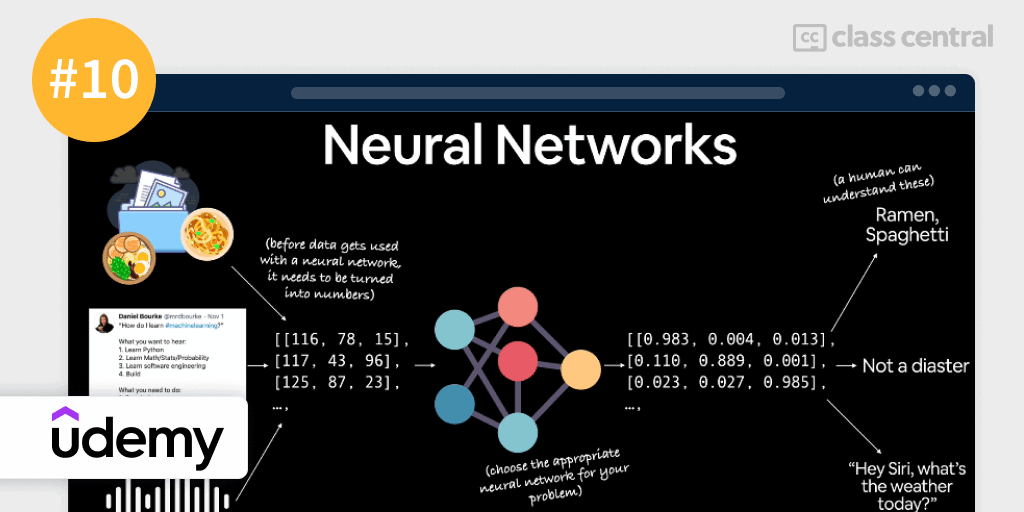
Offered by ZTM Academy, TensorFlow Developer Certificate in 2022: Zero to Mastery aims to provide you with all the skills necessary to ace the TensorFlow Certification and truly stand out from the deep learning crowd!
This paid course is heavily project-based. You’ll do lots of coding exercises, where you’ll build machine learning models and projects that mimic real-life scenarios. More importantly, the course will guide you through TensorFlow, preparing you not only for the exam but also to use TensorFlow out in the world. Upon course completion, you’ll have the skill sets needed to develop modern deep learning solutions..
Proficiency in Python programming is required, and a basic understanding of machine learning is helpful but not strictly necessary. No previous TensorFlow knowledge is required!
What You’ll Learn
You’ll begin with an introduction to the fundamental building blocks of TensorFlow — tensors! You’ll learn how to create tensors, access their attributes and operate on them, and see how they speed up your code.
The course then dives into the idea of neural networks. You’ll start with regression (predicting continuous values) and then get into classification (predicting discrete values). Then, you’ll study the basic components of a neural network, build one up from scratch, and measure its performance.
Afterward, you’ll move on to computer vision — giving machines the ability to ‘see’. Convolutional neural networks are the muscles behind most computer vision tasks. You’ll use them to investigate and solve all kinds of problems.
Training models is extremely time-consuming. What if we could skip that process entirely? Transfer learning does precisely that, and TensorFlow makes it so much easier. You’ll use pre-trained models from the TensorFlow Hub and then compare their performance with TensorBoard. You’ll also learn about feature extraction, fine-tuning, scaling up models, and all there needs to be learned about configuring deep learning models. All of this will lead to your first project: creating a computer vision model that can classify 101 different kinds of foods and beat the original Food101 paper!
Whereas computer vision gives computer sight, natural language processing (NLP) endows computers with speech. Not only is NLP all the rage these days, but it is also a lot of fun! Here, recurrent neural networks are king, and you’ll need to learn how to preprocess text to feed them. You’ll work on another milestone project called SkimLit, where you’ll recreate the PubMed model that classifies different sequences in PubMed medical abstracts to help researchers find relevant papers easily.
Time series problems essentially ask: given historical data, can we predict the future? This type of question is asked especially by companies like Uber, who want to direct their drivers to high-demand areas before the need arises.
The course ends with a few tips on passing the TensorFlow certification exam and what to do after completing the exam.
How You’ll Learn
This course is 64 hours long. You’ll watch a variety of lecture videos and follow along with the instructor in Jupyter Notebook. You’ll also complete three projects that will stretch your knowledge and allow you to apply your skills in real-world projects.
| Organization | Zero To Mastery |
| Provider | Udemy |
| Instructors | Andrei Neagoie and Daniel Bourke |
| Level | Beginner |
| Workload | 64 hours total |
| Enrollments | 26K |
| Rating | 4.7 / 5.0 (3.3K) |
| Certificate | Paid |
Fun Facts
- The course includes a few sections on Pandas, NumPy, and Machine Learning if you aren’t familiar with the basics.
- Andrei is the instructor of some of the highest rated programming and technical courses online and is the founder of ZTM academy.
- Daniel Bourke has a YouTube channel where he talks about data science, machine learning, and his personal life.
If you’re interested in this course, you can find more information about the course and how to enroll here.








Robert D
I am afraid the workshop series titled Introduction to TensorFlow for Artificial Intelligence, Machine Learning, and Deep Learning by DeepLearning.AI is no longer as useful as it once used to be. The TensorFlow exam as of 2022 goes way beyond what is covered by this training series. As a matter of fact, some sections have broken links and outdated assignments. It’s basically being neglected. Even if you fully comprehend the simplistic content of this workshop series you will still fail the exam if you don’t go outside this workshop for more serious coverage of TensorFlow. This workshop series may have once been key to passing the TensorFlow Developer Certification exam. But as of 2022, this is no longer the case. You are better off going thru UDEMY’s free workshop series than paying for Introduction to TensorFlow for Artificial Intelligence, Machine Learning, and Deep Learning by DeepLearning.AI.